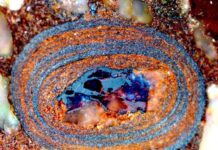Seismologists investigating the deep layers of the Earth previously identified a thin layer called the E prime layer, around a few hundred kilometers thick, whose origin remained a mystery. However, an international team of researchers, including scientists from Arizona State University, has uncovered that water from the Earth’s surface can penetrate deep into the planet, influencing the composition of the outermost region of the metallic liquid core and forming the distinctive E prime layer. The findings were published in Nature Geoscience.
Over billions of years, surface water has descended into the Earth through subducted tectonic plates, reaching the core-mantle boundary about 1,800 miles below the surface. At this boundary, the water undergoes a significant chemical interaction, altering the core’s structure. Through high-pressure experiments, the research team demonstrated that subducted water reacts chemically with core materials, creating a hydrogen-rich, silicon-depleted layer that transforms the topmost outer core region into a film-like structure. This reaction also produces silica crystals that rise and integrate into the mantle.
The modified liquid metallic layer is expected to be less dense, exhibiting reduced seismic velocities in line with anomalies observed by seismologists. The discovery challenges the belief that material exchange between the Earth’s core and mantle is small, revealing a more dynamic core-mantle interaction with substantial material exchange.
The implications of this finding extend to Earth’s internal processes, suggesting a more extensive global water cycle than previously recognized. The altered core film has profound implications for geochemical cycles connecting the surface-water cycle with the deep metallic core. The study utilized advanced experimental techniques at the Advanced Photon Source of Argonne National Lab and PETRA III of Deutsches Elektronen-Synchrotron in Germany to replicate extreme conditions at the core-mantle boundary. The international team, including researchers from ASU, played key roles in conducting high-pressure experiments, computational simulations, and leading the research efforts.















